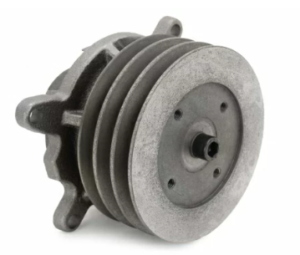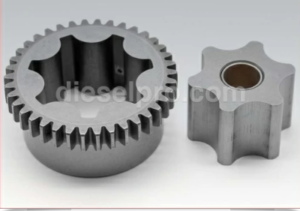
Daily servicing of the Caterpillar 3208 marine engine is crucial to ensure reliable operation, peak performance, and extended service life.
The daily checklist forms the foundation of a sound maintenance routine, enabling operators to identify potential problems early, ensure optimal fluid levels and system conditions, and verify that safety systems are operational. This section provides a detailed, step-by-step guide to daily maintenance procedures, supported by best practices, explanations, and safety considerations.
Walk-Around Inspection for Leaks and Loose Connections

Purpose of the Walk-Around Inspection
A walk-around inspection is a simple yet powerful procedure that enables early detection of leaks, loose connections, and signs of wear. This inspection can prevent small issues from becoming significant problems, reducing the risk of unplanned downtime.
Key Areas to Inspect
-
Engine compartment floor and bilge: Look for pooled fluids such as oil, coolant, or fuel.
-
Engine block and gaskets: Check for signs of seepage or cracks.
-
Hoses and clamps: Inspect for cracks, bulges, or loose fittings, especially at connection points.
-
Fuel system: Look for dampness, drips, or a diesel smell, indicating leaks.
-
Lubrication system: Check around oil filters, drain plugs, and oil lines for signs of leakage.
-
Cooling system: Inspect hoses, clamps, the water pump, and heat exchanger connections.
-
Belts and pulleys: Look for wear, fraying, or misalignment.
Best Practices
-
Wipe down surfaces as needed to confirm the source of leaks.
-
Use a flashlight to check under and behind components.
-
Record any observations in a daily log for tracking purposes.
Checking Cooling System Coolant Level

Importance of Coolant Level Checks
The cooling system is essential for maintaining engine temperature within safe operating limits. Low coolant levels can lead to overheating, which may cause cylinder head cracking, piston seizure, or catastrophic engine failure.
Step-by-Step Procedure
-
Allow the engine to cool: Never open the coolant system while the engine is hot. Hot coolant under pressure can cause severe burns.
-
Locate the coolant reservoir or filler cap: Some engines use a pressurized system, while others have a recovery tank.
-
Check the level: The coolant should be at or slightly below the “FULL” mark when the engine is cool.
-
Top up if necessary: Use Caterpillar-approved coolant mixtures to replenish. Never mix coolant types or use plain water.
-
Inspect for leaks: Look for dried coolant residue or wet spots around hoses, clamps, and the water pump.
Safety Tips
-
Use gloves and eye protection.
-
Dispose of any spilled coolant properly to prevent environmental contamination.
Inspecting the Engine Air Cleaner Service Indicator
Function of the Air Cleaner Service Indicator
The air cleaner service indicator monitors the pressure drop across the air cleaner element. As the element becomes dirty, airflow restriction increases, causing the indicator to display a warning.
Steps to Inspect the Indicator
-
Locate the service indicator: Usually mounted on or near the air cleaner housing.
-
Observe the indicator:
-
If the indicator shows “green” or the piston is reset, the filter is functioning properly.
-
If it shows “red” or the piston locks in the warning position, the filter needs to be cleaned or replaced.
-
-
Test the indicator’s functionality:
-
Accelerate the engine to high idle and observe indicator movement.
-
Reset the indicator by pressing the reset button and confirm it returns to “green.”
-
Importance
A clogged air filter can cause engine inefficiency, power loss, and increased fuel consumption. Regular checks ensure optimal airflow and combustion efficiency.
Checking Engine Oil Level

Why It’s Crucial
Oil lubricates critical engine components, reduces friction, and removes heat. Low oil levels can lead to bearing failure, piston seizure, and engine damage.
Procedure
-
Stop the engine and wait 10 minutes for oil to drain into the sump.
-
Locate the dipstick (engine oil level gauge).
-
Wipe the dipstick clean, reinsert fully, and withdraw to check the oil level.
-
Compare the reading to the “ADD” and “FULL” marks.
-
If low, add oil specified in the OEM manual.
-
Do not overfill, as excess oil can cause foaming, increased crankcase pressure, and oil leaks.
-
Inspect for leaks: Check around the oil filter, drain plug, and oil lines.
Best Practices
-
Always use OEM-approved oils and maintain a record of oil additions.
-
Check oil color and consistency for signs of contamination or fuel dilution.
Draining the Fuel System Water Separator

Importance of Water Separator Maintenance
Marine environments expose fuel systems to moisture. Water in the fuel can cause:
-
Injector damage,
-
Reduced combustion efficiency, and
-
Microbial growth (fuel algae), leading to clogged filters.
Steps to Drain the Separator
-
Locate the water separator drain plug or valve.
-
Close the fuel supply valve if necessary.
-
Place a container to collect water and fuel.
-
Open the drain and depress the vent valve to allow water to drain until clear diesel flows.
-
Close the drain plug or valve and ensure it’s secure to prevent air ingress.
-
Dispose of collected water/fuel mix per environmental regulations.
Daily Check Frequency
Drain the separator daily, especially in humid or coastal areas, or when condensation risk is high.
Checking Marine Transmission Oil Level
Purpose of the Check
The marine transmission is essential for transferring engine power to the propeller. Low oil levels can cause overheating, gear wear, and transmission failure.
Procedure
-
Warm up the engine and shift through all gears to circulate oil.
-
Stop the engine and wait a few minutes.
-
Locate the transmission dipstick and remove it.
-
Wipe it clean, reinsert, and withdraw to check the oil level.
-
Add oil if needed using the recommended lubricant.
-
Inspect for leaks around seals and cooling lines.
Pro Tips
-
Use only OEM-recommended transmission fluids.
-
Check the oil condition (color, smell) for signs of overheating or contamination.
Summary of Daily Servicing Benefits
Regular daily servicing of your Caterpillar 3208 provides:
-
Early detection of leaks, wear, and system issues.
-
Consistent performance through optimal fluid levels and clean air intake.
-
Extended engine life by preventing overheating and lubrication failures.
-
Compliance with manufacturer guidelines to protect warranty and ensure safety.
Proactive Daily Checklist for the Caterpillar 3208
| Task | Procedure Highlights | Notes |
|---|---|---|
| Walk-Around Inspection | Check for leaks, damage, loose components | Use flashlight and daily log |
| Cooling System Coolant Level | Verify at reservoir or filler neck | Only check when engine is cool |
| Air Cleaner Service Indicator | Inspect visual indicator for restriction | Reset and retest if needed |
| Engine Oil Level | Check dipstick, add oil as needed | Allow 10-minute settling post-run |
| Fuel System Water Separator | Drain water until clear fuel flows | Dispose waste per regulations |
| Marine Transmission Oil Level | Check dipstick after circulation | Use OEM-recommended fluid |
Final Thoughts on Daily Maintenance
A proactive daily maintenance routine is the cornerstone of safe, reliable, and cost-effective marine operations. By dedicating time each day to these essential checks and actions, you’re ensuring that your Caterpillar 3208 marine engine delivers the performance, efficiency, and longevity it was designed to offer.
Always consult the official Caterpillar Operation & Maintenance Manual for precise procedures, torque specifications, and OEM recommendations. Consistent adherence to daily checks not only enhances safety and performance but also builds a culture of responsibility and operational excellence aboard your vessel.
Additional Resources
Practical Guide To Servicing The Caterpillar 3208 Marine Engine
Marine CAT 3208 Component Maintenance Life
Keeping the Caterpillar 3208 Marine Engine Running: A Retrospective and How Diesel Pro Power Supports It
Caterpillar 3208 Injectors: High-Quality Aftermarket Options from Diesel Pro Power
The History of the Caterpillar 3208 Engine
Common Applications of the Caterpillar 3208 Engine
Troubleshooting Common Issues with the Caterpillar 3208
Maintenance Tips for Maximizing the Life of Your Caterpillar 3208 Engine
Comparing the Caterpillar 3208 to Other Marine Engines



 Free US Calls: 1-888-433-4735
Free US Calls: 1-888-433-4735 International: 305-545-5588
International: 305-545-5588